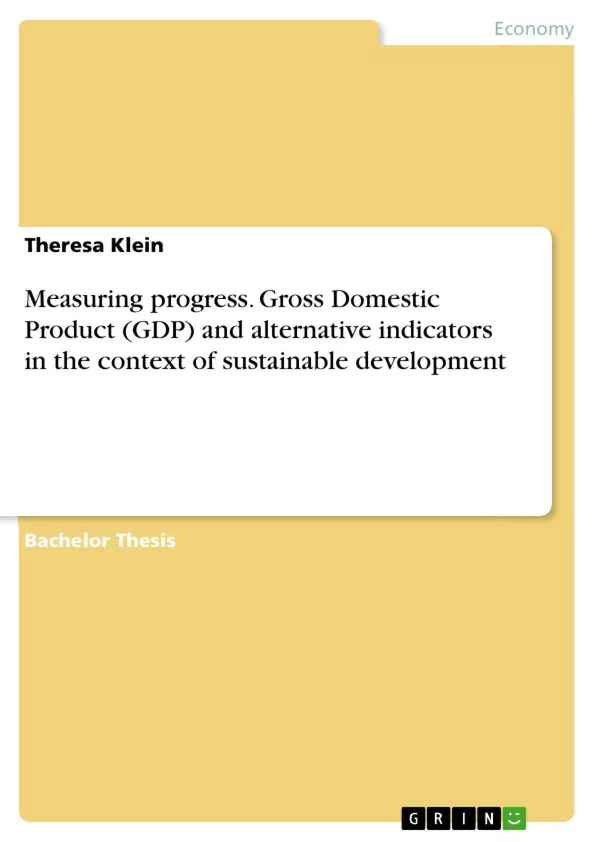Blick ins Buch

Measuring progress. Gross Domestic Product (GDP) and alternative indicators in the context of sustainable development
Bachelorarbeit, 2021
56 Seiten, Note: 1,3
Leseprobe
Inhaltsverzeichnis (Table of Contents)
- 1. Introduction
- 1.1 Problem description
- 1.2 Objective and methods
- 2. Sustainable development and GDP
- 2.1 Defining sustainable development
- 2.2 Defining GDP - Definition and calculation
- 2.3 Creating GDP - The development of GDP
- 2.4 Drawbacks and limitations of GDP
- 2.4.1 Economic drawbacks
- 2.4.2 Ecological and social drawbacks
- 2.5 Benefits of the GDP
- 3. Implications for policy making
- 3.1 Importance of indicators for political decisions
- 3.2 GDP affecting economic decisions and policy making
- 3.3 Barriers to change GDP
- 3.4 Political efforts towards sustainable development
- 3.4.1 Stiglitz-Sen-Fitoussi Commission
- 3.4.2 Enquete Commission "Growth, Prosperity, Quality of Life"
- 4. Alternatives to GDP in support of sustainable development
- 4.1 Indicators adjusting GDP
- 4.1.1 Index of Sustainable Economic Welfare (ISEW) and Genuine Progress Indicator (GPI)
- 4.1.2 Green GDP
- 4.2 Indicator sets supplementing GDP
- 4.2.1 Green satellite accounts
- 4.2.2 Sustainable Development Goals (SDG)
- 4.3 Indicators replacing GDP
- 4.3.1 Human Development Index (HDI)
- 4.3.2 Ecological Footprint (EF)
- 4.3.3 Case Study: Bhutan's Gross National Happiness (GNH)
- 4.4 Correlations between GDP and sustainability elements
- 5 Discussion
Zielsetzung und Themenschwerpunkte (Objectives and Key Themes)
This thesis examines the limitations of GDP as a measure of genuine progress in the context of sustainable development and proposes alternative indicators to better represent the economic, social, and ecological dimensions of sustainability.- The suitability of GDP as a progress indicator.
- The relevance of GDP in policy making.
- The drawbacks and limitations of GDP.
- Alternative measures of sustainable development that adjust, supplement, or replace GDP.
- The challenges and benefits associated with implementing alternative indicators.
Zusammenfassung der Kapitel (Chapter Summaries)
- Chapter 1 introduces the problem of using GDP as a measure of progress in the context of sustainable development and outlines the objectives and methods of the thesis.
- Chapter 2 defines sustainable development and GDP, exploring its history, drawbacks, benefits, and limitations in portraying genuine progress. It discusses the economic, ecological, and social aspects of sustainability in relation to GDP.
- Chapter 3 examines the implications of using GDP as a primary indicator for policy making, highlighting its influence on economic decisions and the challenges in transitioning to alternative measures. It explores the efforts of organizations like the Stiglitz-Sen-Fitoussi Commission and the Enquete Commission in promoting sustainable development.
- Chapter 4 delves into alternative indicators that can be used to assess sustainable development, categorized into those that adjust, supplement, or replace GDP. This chapter discusses various indicators such as the Index of Sustainable Economic Welfare (ISEW), Genuine Progress Indicator (GPI), Green GDP, Green Satellite Accounts, Sustainable Development Goals (SDG), Human Development Index (HDI), Ecological Footprint (EF), and Bhutan's Gross National Happiness (GNH).
Schlüsselwörter (Keywords)
The thesis focuses on key concepts like sustainable development, GDP, alternative indicators, economic, social, and ecological dimensions, policy making, and the challenges associated with transitioning to more comprehensive measures of progress. It explores diverse indicators such as ISEW, GPI, Green GDP, SDG, HDI, EF, and GNH, evaluating their strengths and weaknesses in representing sustainable development.
Ende der Leseprobe aus 56 Seiten
- nach oben
Details
- Titel
- Measuring progress. Gross Domestic Product (GDP) and alternative indicators in the context of sustainable development
- Hochschule
- Fachhochschule Dortmund
- Note
- 1,3
- Autor
- Theresa Klein (Autor:in)
- Erscheinungsjahr
- 2021
- Seiten
- 56
- Katalognummer
- V1032810
- ISBN (eBook)
- 9783346440518
- ISBN (Buch)
- 9783346440525
- Sprache
- Englisch
- Schlagworte
- measuring gross domestic product GDP
- Produktsicherheit
- GRIN Publishing GmbH
- Preis (Ebook)
- US$ 19,99
- Arbeit zitieren
- Theresa Klein (Autor:in), 2021, Measuring progress. Gross Domestic Product (GDP) and alternative indicators in the context of sustainable development, München, Page::Imprint:: GRINVerlagOHG, https://www.diplomarbeiten24.de/document/1032810
Allgemein
Autoren
- Autor werden
- Ihre Optionen
- Vertriebskanäle
- Premium Services
- Autorenprofil
- Textarten und Formate
- Services für Verlage, Hochschulen, Unternehmen
Premium Services
FAQ
Marketing
Dissertationen
Leser & Käufer
Zahlungsmethoden

Copyright
- © GRIN Publishing GmbH.
- Alle Inhalte urheberrechtlich geschützt. Kopieren und verbreiten untersagt.
- info@grin.com
- AGB
- Open Publishing
Über GRIN
Der GRIN Verlag hat sich seit 1998 auf die Veröffentlichung akademischer eBooks und Bücher spezialisiert. Der GRIN Verlag steht damit als erstes Unternehmen für User Generated Quality Content. Die Verlagsseiten GRIN.com, Hausarbeiten.de und Diplomarbeiten24 bieten für Hochschullehrer, Absolventen und Studenten die ideale Plattform, wissenschaftliche Texte wie Hausarbeiten, Referate, Bachelorarbeiten, Masterarbeiten, Diplomarbeiten, Dissertationen und wissenschaftliche Aufsätze einem breiten Publikum zu präsentieren.
Kostenfreie Veröffentlichung: Hausarbeit, Bachelorarbeit, Diplomarbeit, Dissertation, Masterarbeit, Interpretation oder Referat jetzt veröffentlichen!
- GRIN Verlag GmbH
-
- Nymphenburger Str. 86
- 80636
- Munich, Deutschland
- +49 89-550559-0
- +49 89-550559-10
- info@grin.com
-









